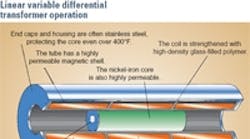A linear variable differential transformer (or LVDT) is an electromechanical transducer that reports position by converting the linear motion of an object (to which it is mechanically coupled) into an electrical signal. In short, a metal rod core is propelled back and forth (by the mechanism's motion being measured) inside a tube called the coil. Different axial core positions induce differential ac voltages between the tube's secondary windings. Then this ac voltage is translated into signals used to report position.
The basic technology has remained unchanged since its introduction six decades ago, but embedded electronics have improved their performance. Case in point: Newer LVDTs with microprocessors self-correct errors caused by sensor characteristics or the environment, so while standard LVDT sensors may have ±0.25% linearity, an LVDT with microprocessing can linearize output to ±0.05% of full-scale output. In addition, LVDT linear sensor repeatability is limited only by the mechanical imperfections of the physical structures to which the LVDT's core and coil are attached — because LVDTs with the latest windings (manufactured via computer controls) have unit-to-unit sensitivities to within ±1% instead of the typical ±5%.
Q&A
Where can LVDTs operate?
LVDT position sensors operate in hostile environments — in high and low temperatures, under radiation and corrosive chemical exposure, and underwater or in vacuums. Hermetically sealed or vented, LVDTs made of stainless steel and Inconel 718 for pressure and corrosion resistance are reliable for years, even in seawater. For shallow and warm waters with high levels of oxygen, housings of Monel 400, a nickel-based alloy, resist pitting and attack by microorganisms. LVDTs with titanium and Hastelloy housings reliably measure position underwater to 7,500 ft and 3,800 psi for 10 years or more. Finally, for sulfidation environments in the presence of heavy H2-H2S concentrations to 425° C, LVDT linear position sensors constructed from cobalt, nickel, and chromium alloys with mineral insulation perform where other sensors fail — for instance, in offshore applications, downhole drilling, and power generation.
Do these sensors only measure long strokes?
The newest LVDTs accurately measure displacement from micro inches to two feet. In addition, computerized layer winding and smaller embedded microprocessors have made the units up to 80% more compact for a given stroke length. LVDT dimensions now rival those of magnetostrictive sensors for short-stroke actuators and cylinders of less than 6 in. — useful in machine tool and hydraulic cylinder positioning, valve position sensing, and automatic assembly equipment. Lightweight cores also boost dynamic response and reduce weight — useful in aircraft and on satellites.
How are LVDTs programmed?
Traditional ac-operated LVDT linear position sensors require a separate signal conditioner, though the time to calibrate the two components together (and additional equipment to do so accurately) can double or triple effective price. For applications where these ac sensors and separate electronics are nevertheless required, pushbutton zero and span controls have replaced digital pots and improved software has reduced the time needed for calibrating and selecting gain.
Otherwise, a more cost-effective option is dc-operated LVDT linear position sensors with electronics embedded into the sensor housing. Here, electronics include drive and processing circuitry to adjust drive frequency and speed and noise filtering. Analog-to-digital cards have also been eliminated: High-density microelectronics incorporate signal conditioning and processing functions inside the LVDT housing (and do away with an external box) and the digital output is directly compatible with computer-based systems and standard buses. Where installed, local screens can also display information from the sensors in plain engineering units. Already used in metrology, the smart sensors could improve control and reduce cabling in other industries.
This month's handy tips provided by John Matlack of Macro Sensors, Pennsauken, N.J. For more information, visit www.macrosensors.com or email [email protected].


